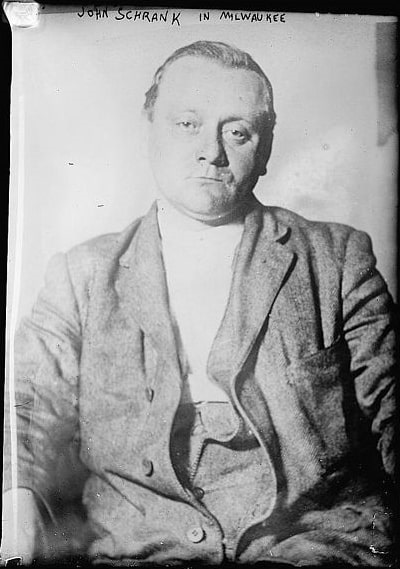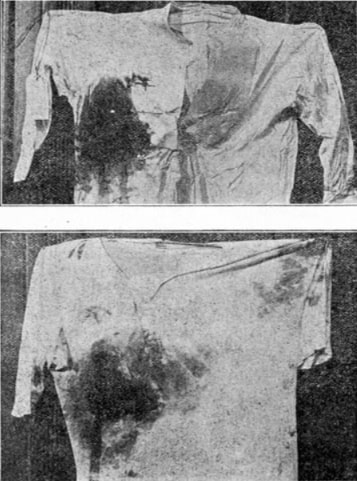Please Follow us on Gab, Minds, Telegram, Rumble, Gettr, Truth Social, Twitter
During the 1912 presidential election, Americans opened their newspapers in mid-October and discovered shocking news. Former President Theodore Roosevelt, who was running for president again, was shot on October 14 by a would-be assassin in Milwaukee, Wisconsin, while on his way to deliver a campaign speech.

For years Roosevelt had been a larger-than-life personality in various positions as New York state assembly man, New York City police commissioner, assistant secretary of the Navy, and governor of New York. Because he was the center of gravity wherever he went, Roosevelt’s daughter Alice once quipped that he was “the bride at every wedding and the corpse at every funeral.”
The October 1912 assassination attempt did not kill Teddy Roosevelt.
“Bullet of an Assassin Wounds Col. Roosevelt,” the Boston Journal reported of his injury. “Col. Theodore Roosevelt – shot in the right breast as he left his hotel to speak at the auditorium – miraculously escaped assassination.”
Although Roosevelt had served as president of the United States from 1901 to 1909, newspaper editors still referred to him as colonel, a nod to his military service and heroism during the Spanish-American War.
Astoundingly, Roosevelt had placed his steel eyeglass case and his 50-page speech in the right breast pocket of his jacket – precisely where the bullet landed. The two objects slowed the bullet’s impact, and it lodged in Roosevelt’s chest muscle without penetrating his lung.
“Colonel Roosevelt Shot by Assassin – Manuscript Shields Teddy from Bullet” the Aberdeen Daily American ran as their headline.
This article reports:
A positive statement that Roosevelt is not seriously injured was made by Dr. Frederick Stratton of Milwaukee, who examined the colonel and declared there was no cause for alarm.
“The wound is a superficial one,” said the physician. “The bullet embedded in the muscular tissue. The bullet positively didn’t reach the lung and there is no truth in the reports that he is dangerously hurt.”
The shooter was John Schrank, a German immigrant who lived in New York but had traveled to Wisconsin. When the police searched Schrank at the police station, they found notes in his pocket declaring that he had been visited by the spirit of President William McKinley.

Roosevelt was elected vice president for President William McKinley’s second term in 1900. When McKinley attended the Pan-American Exposition in Buffalo, New York, on 6 September 1901, he was shot twice in the abdomen by an anarchist, Leon Czolgosz. McKinley died a few days later. Becoming president, Roosevelt completed McKinley’s term and won a second term in 1904.
Although he wanted to run for president again in 1908 and the law permitted it, Roosevelt didn’t think the American people would approve of his decision to break the two-term tradition started by President George Washington.
Instead, Roosevelt convinced his war secretary, William Howard Taft, to run as the Republican nominee in 1908. Taft won. Roosevelt, however, wasn’t satisfied with his chosen successor. Unhappy with Taft’s policies, Roosevelt ran for president again in 1912 against both Taft and Woodrow Wilson, the Democratic candidate. Roosevelt represented the Bull Moose Party when he ran for a third term.
As it turned out, Roosevelt’s would-be assassin, Schrank, was upset that Roosevelt was running for a third term. Schrank claimed that McKinley had come to him in a vision and told him that Roosevelt had killed him. “This is my murderer. Avenge my death,” Schrank had written in his notes. He confessed to firing a shot against Roosevelt and declared that “any man looking for a third term ought to be shot,” as the Aberdeen Daily American reported.
Some politicians, however, blamed newspapers for Schrank’s delusions.
This article reports:
“The attempted assassination of Colonel Roosevelt was a great shock to me,” said [West Virginia] Gov. William E. Glasscock tonight, “as it was to the people of this country; it is another crime to be laid at the door of yellow journalism. As long as the press of this country spends as much time and devotes as much space as it has in the past few years in inflaming the minds of the weak and the views against public men who may entertain views contrary to the owners and editors of such papers and have the courage to stand up for their convictions, just so long will the lives of public men be endangered. It is time for such things to stop.”
Coined as a term in the 1890s, “yellow journalism” was sensationalized news printed in newspapers to attract readers and boost sales. Yellow journalism was born out of a competition between two New York City newspapers: the World and the Journal. Glasscock was not a fan of yellow journalism.
Glasscock concluded that Roosevelt and his cause would not be deterred.
As the newspapers reported, Roosevelt showed in the moments immediately following the shooting that the assassination attempt had not shaken him. Because Schrank was arrested right after firing his shot and the former president’s wound was superficial, Roosevelt insisted on delivering his speech before going to the hospital. Once there, doctors concluded it was safer to leave the bullet where it was than try to remove it, and Roosevelt carried the bullet lodged in his chest muscle for the rest of his life.

With blood seeping into his shirt, Roosevelt traveled to the auditorium and spoke to the crowd for 50 minutes. His opening words were:
“Ladies and gentlemen, I don’t know whether you fully understand that I have just been shot, but it takes more than that to kill a Bull Moose.”
Within three weeks, Republicans split their votes between Roosevelt and Taft in the 1912 presidential election. Woodrow Wilson won. Roosevelt died a few years later in 1919 of a coronary embolism.
